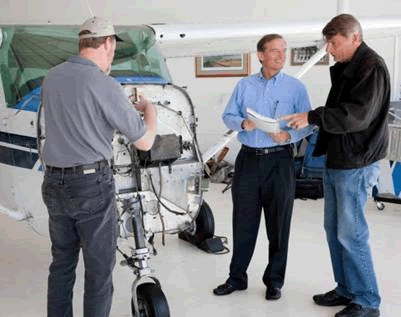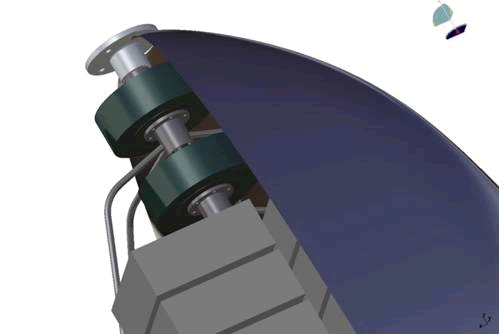In a press release datelined Oshkosh, Wisconsin, July 26, Cessna Aircraft Company announced, “That it is collaborating with Bye Energy, Inc., an integrator of clean, alternative energy technologies for business and general aviation aircraft, to design and develop an electric propulsion system for a Cessna 172 proof of concept (POC) aircraft.”
Bye Energy is a Colorado-based aerospace company, and its CEO, George Bye, presented the Green Flight Project, his vision of the electric 172 at this year’s Electric Aircraft Symposium in Rohnert Park, California on April 24. The fact that Cessna would agree to such collaboration is a significant step, and a verification of the market research Bye and his group have done. Possibly fueled by the fuel question – where will future pilots top up their avgas-burning aircraft? – Bye’s solution is one approach that is immediately achievable with current off-the-shelf components, with Bye and Cessna expecting first flights of the newly powered airplane by year’s end.

Bruce Gillit, Bye Engineering Manager, George Bye, Bye Energy CEO and Charlie Johnson, Bye Energy COO work on the first conversion steps
The aging fleet and high prices for maintaining what are increasingly vintage engines adds to the economic burden of flying, as noted by Bye in his EAS talk. That, and the popularity of the 172, with 43,000 delivered, makes the Cessna an ideal candidate for the transformation. As Charles Johnson, former Cessna President and Chief Operating Officer for Bye Aerospace notes, this is “the largest possible application,” for electric conversions, enabling economies of scale to take hold.
In his talk, Bye noted that the electric 172 would weigh about 1,300 pounds empty, including a 168 horsepower UQM 125 motor, batteries, and a Vertical Power monitoring system. That weight would be maintained even with a projected hybrid package that would use a GSE OCX-1226 engine as part of a series configuration, the Diesel engine being used to recharge the probably smaller battery pack.
In the pure electric version, Bye noted, a second battery pack would take up the rear seat area. Although some might raise objections, consider “normal” use of a petrol-powered 172. It’s often used as a two-seater with ample room for luggage. Little will change for such use.
Performance, in many respects, will improve because of the smoother cowling possible with the smaller motor and lower need for cooling drag, a major factor on internal combustion powered craft. Bye estimates a minimum thrust requirement of 30.6 kilowatts, or 41 horsepower for economical cruise. With a variable pitch, full feathering propeller, climb and cruise performance should be enhanced, and with the electric motor’s ability to maintain power at higher altitudes, low cruise speed at high altitudes will be an economical way to travel.
In that respect, Bye projects a $5.00 to $6.00 an hour direct operating cost, given electric rates of 10 cents per kilowatt-hour. That’s an order of magnitude less than the conventionally powered craft. Maintenance costs will be similarly cut, making annual inspections far less of a fiscal imposition.
Besides the hybrid package, future developments will include incorporation of Ascent Solar thin-film solar cells on the wing to act as a range extender in flight and self-charging system on the ground.
The press release concludes, “Cessna’s Chairman, President and CEO Jack J. Pelton said, ‘As we look at the landscape of alternative fuels for general aviation aircraft, the electric power plant offers significant benefits, but there are significant challenges to get there. We believe Bye Energy has gotten off to a good start in understanding those challenges and how to overcome them.’
“George Bye, CEO of Bye Energy Inc., thanked Cessna for its collaboration. ‘We are honored to work with Cessna in accomplishing the proof of concept endeavor. Cessna’s support of the electric and electric-hybrid program is vital to moving general aviation into the future,’ he said.
“Representatives from Bye Energy will be at the Cessna exhibit during EAA’s AirVenture on Thursday, July 29, 11 a.m. to 3 p.m., for one-on-one interviews.”


Comments 2
GO GO GO ELECTRIC !!
I received my A&P in1969 I have seen a lot of changes but I have always thought especially in recent years as battery and motor designs got better that electrics could be part of aviation . My father ran power plants and often said that cars buses and even airplanes one day could be electric . He was an aviaton electrician in WWII and was very inventive . As a part time airport mgr. for ten years N 81 N.J.I have thought that if light airplanes could go electric we could have solar cell on the hangar roofs and charge the batteries while not in use . This could be part of the tie down or hangar fee . I also like the hybrid idea of a small engine to charge you up if needed . My other thought was to have a small engine to the prop and have an electric motor push the engine when more power was needed . I also like the idea of photo cell built into the top of the wings and fuselage . Andy Kondrach
I am doing a preliminary survey to find out if there is enough interest for the Electric Aviation Industry to bring aircraft to the Reno Air Races for the purpose of display, flight demo, and possibly race in a closed course category.
If this would interest your company, please return an email and explain what your interest would be.
Thank you
Bill Meyer